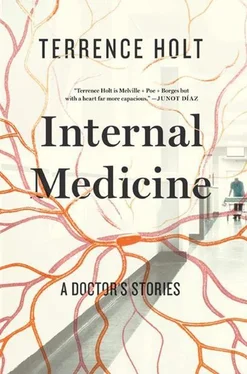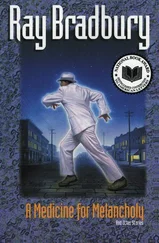“I can’t,” I gritted out. “DNI.”
“BiPAP?”
“I can’t get her to wear an ordinary face mask.”
“Why don’t you just snow her?”
It was a thought. She hadn’t refused the morphine. I could try adding on sedation until she would let me put a mask on her — perhaps even a tight-fitting BiPAP mask, the next-best thing to intubation. It could be done.
“Yeah,” I said. “Nurse? Bring me four of Ativan. And another four of morphine.”
I knew the risk: knock her out too far and her respiratory drive would suffer; she’d lose her airway; she’d suffocate.
But she was going to die this way, too. I watched, holding my breath as the drugs went in, trying to remember the doses of naloxone and flumazenil that would reverse these, if I had to.
Her breathing settled still more. Her eyelids fluttered and fell. “Get a mask on her,” I said.
In a minute the tech had her fitted with an elaborate device that gripped her face like a diver’s mask. There was no protest. The pulse-ox rose steadily to ninety, ninety-one, settled at ninety-two. I let out a sigh.
This time I did sleep. I must have, because my pager woke me from a dream of too many inscrutable objects, none of them fitting together, a puzzle I had to solve.
“Doctor? Twenty-six. She’s fighting the mask.”
SHE WAS SITTING UP, crouched as if clutching some secret to her chest. The mask was pushed up onto her forehead. Her shoulders rose and fell, rose and fell. She didn’t look up as I entered; her gaze lay burning on the opposite wall.
The pulse-ox was eighty-two.
I laid a hand on her shoulder, could feel her bones working as it rose and fell.
“Mrs. B.”
She shook her head.
“We’ve got to do something.”
She shook it again.
“What can I do for you?”
Her hand waved me away.
I stood beside her, watching her breathe, for a very long time. She lay on the bed within reach of my outstretched hand, within the sound of my voice, but behind the wall of her fatigue and her breathlessness, sunk deep in her adamant gaze, she was unreachable. Unreachable by me. I wondered if she even knew I was still there, and felt suddenly a revulsion — not at her, but at my own presence in her room.
Her pulse-ox was eighty-two.
“Call me,” I said to the nurse, “if she changes.”
AROUND SIX A.M. I was sitting in the call room, trying to shake myself awake. My pager went off. It was the eighth floor.
The room was different now. Light was striking in through the window, a dozen rising suns reflected off the opposite tower. The room was bright and still.
Fast asleep, even comatose, a living body moves. The chest expands, the nostrils flare, the eyelids twitch; pulses stir the skin, and over all of these there hovers an inarticulate hum of life. But a dead body is only that: dead, a body, given over to gravity and decay. The muscle tone that lends expression to the face is gone; the face is slack; the skin gone gray-green with the absence of blood (underneath, if you turn it over, you will find pooled at the backside a livid bruise).
I went through the motions of declaring death. Her eyes took my flashlight passively, the beam falling into the cloudy darkness of her pupils without a sign. I laid a stethoscope on her chest: only sporadic pings and creaks, sounds of a building settling in the night. Her flesh was cold, malleable, inert.
There were papers to fill out: organ donation, autopsy permission, the death certificate. I puzzled over “Cause of death,” wondering just what process I had failed to reverse.
Respiratory failure , I finally wrote, secondary to pulmonary fibrosis, secondary to systemic sclerosis . The last line asked if any underlying medical conditions (diabetes, hypertension, for example) had contributed to the patient’s demise. I looked at that a long time, and finally left it blank.
By the time I was done, the hospital had come to life around me. The intern who had signed out Mrs. B to me scratched the name off her patient list.
Keith, the resident, appeared on the floor just before rounds got under way. “How was your night?”
I told him. He listened to the story, pulled his lower lip, shook his head.
“You should have called me.”
I flinched. “What would you have done?”
“Nothing,” he said. “Just like you. There was nothing to do. But at least we could have done it together.”
IT’S ONE OF THOSE ICONS OF MEDICAL TRAINING, something you spend an afternoon discussing in the preclinical years and then gratefully forget, like community health or Medicare billing requirements. I don’t remember anything we learned that day. All that stayed with me was a vague solemnity, a sense of having spent the afternoon in the middle of an Emily Dickinson poem — not one of the cheerful ones — and coming out of it about as wise for the experience. And so, as is inevitable with the lessons we tune out, it wasn’t long before I learned this one the hard way.
He was a forty-three-year-old with pneumonia. I was an intern on the infectious-disease service. He belonged there only slightly more than I did. He did have pneumonia, but pneumonias aren’t really all that infectious (most of them), and on a service crowded with HIV his presence was anomalous, more an accident of ER timing than a reasoned assignment from admissions. He had come up from the ER around two in the morning, admitted by the night float resident and placed on my service. His story was unremarkable. He had developed a cough, then fevers and shaking chills that bought him a five-day course of azithromycin from his primary MD. When he’d failed that, the primary had tried him on levofloxacin, a reasonably big gun. When he’d failed that, the primary had sent him to the hospital “for further eval.”
It’s part of the nature of the hospital where I trained (as it is with most teaching hospitals) that patients arrive without a great deal of documentation. In the typical community hospital, if you’re unlucky enough to find yourself hospitalized you at least have the consolation of knowing that your own doctor, who presumably knows your medical history, is going to be treating you. But admitting privileges at this facility are reserved for faculty of the medical school, who divide their time between laboratories, clinics, and the floor. When patients come here from what we generally call “outside docs,” they usually arrive without any more medical information than the patient can recall.
If the patient is well educated, articulate, and interested in his health, that information can be complete — sometimes too complete. But usually the patient is none of the above. I wouldn’t have had it any other way, but at times this complicated my attempts to understand what was going on. As with this time. The history and physical on the chart didn’t say very much: the acute pneumonia, no other medical history (not unusual in a forty-something man), a high school education, and a smoking habit. Not employed, living with family. No meds.
As for the patient’s current state of health, that was somewhat more complex. In addition to the pneumonia, which had him coughing up “bad phlegm” these past two weeks, he had reported some difficulty swallowing and a weight loss he could only quantify by saying that he’d taken in three notches on his belt since last Spring.
The resident said immediately, “That’s not good.”
I looked at him.
“Weight loss, difficulty swallowing, resistant pneumonia in a middle-aged male smoker,” he said.
“Ah,” I said, scanning the rest of the chart for a clue. The orders left by the night float resident included not the chest CT and bronchoscopy I had expected but an EGD — one of those gastrointestinal procedures where they stick a lighted tube down your throat and examine the inner lining of your stomach. “Ah,” I said again.
Читать дальше












